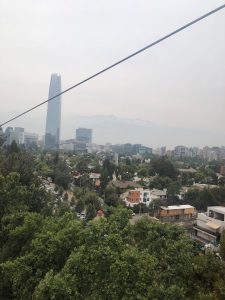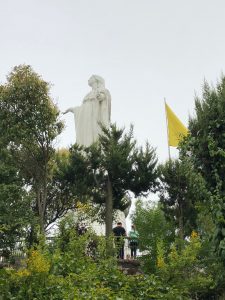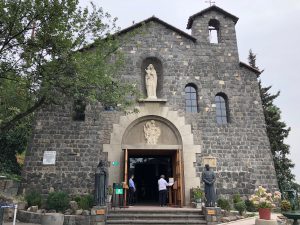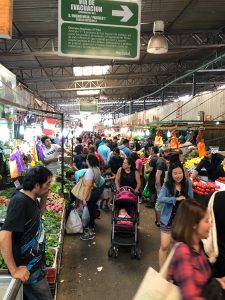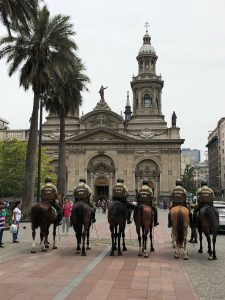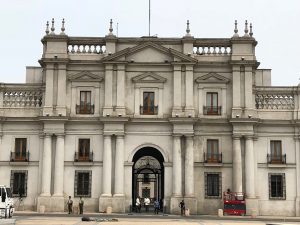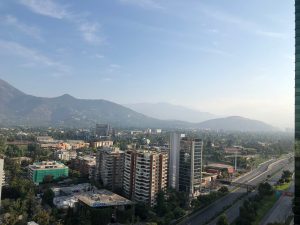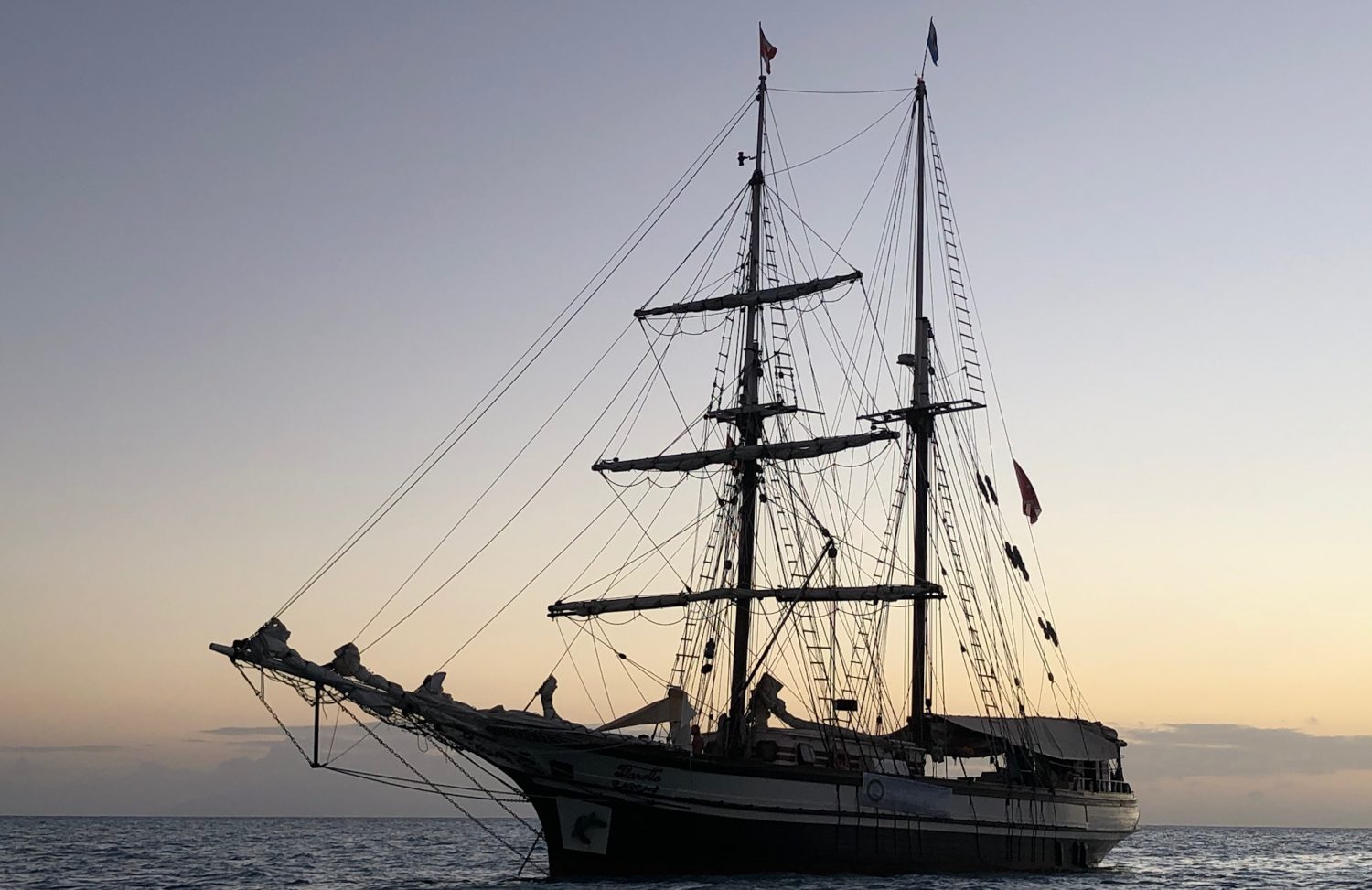Santiago is a city of 5 million people, and lies in what appears to be a bowl, with hills and the Andes surrounding it. As a result, it was overcast, or smoggy the days we were there, making the views we had hoped for not visible. First discovered in 1520 by Magellan, Chile was originally a Spanish Colony. Chile declared independence in 1818, making this it’s centennial year, although Spain didn’t accept the declaration until 1840. Known for it’s extensive copper mines, and strong in agriculture and fishing exports, Chile is the strongest economy in LA, and has had a stable democracy for the last several decades, after years of unrest and changes in government. Chile is also known for Lapislazuli, a semi-precious stone only found here and in Afghanistan.
The hop-on, hop-off bus around the city seemed a perfect solution to a one day exploration of Santiago, easier than identifying specific sights to see and sorting out how to get from here to there on what is said to be a well-designed and functioning metro. It was a slow bus, but also helpful in describing the different areas of the city, some history, as well as local lore.
We got off at the first stop, where it was possible to take a cable car to the top of a small mountain in the largest city park in all of Latin America, called Parque Metropolitano. It reminded us both of Griffith Park, both in size and with the high peak in the center. There was a paved road up to the top, in addition to pedestrian dirt paths, and a cycling event of some sort was underway. We watched scores of people making the difficult trip up to 2,600 feet on two wheels from the comfort of our small gondola car. At the top of San Cristobal hill was a small chapel and a large statue of the Virgin Mary (The Immaculate Conception), in what seemed to be white granite or marble, viewable from any spot in the city, sort of like the Christ the Redeemer statue in Rio. Around the base were several smaller bronze icons, and what appeared to be crypts or perhaps just memorials to some people who had died. One way down from the mountain is the funicular, which was unfortunately out of order. The cars were sitting at the top station, and the track looked to be a 45 degree angle down. So I was sorta okay choosing to walk down instead. Finding the path was a little tricky, but once found, it was an easy mile plus to the street.
We arrived in the Bella Vista neighborhood, which is known for it’s shops and cafes and sort of artistic vibe. There’s one enclosed market area — Patio Bella Vista — with lots of places to eat and things to buy, so after browsing we stopped for lunch at a restaurant claiming to offer Peruvian style sushi. It was an interesting take on fresh fish. We had thought this market was going to have more handicrafts, but had remembered reading about La Vega Market, so thinking that was more what we had anticipated we walked to that area, north of the river. It wasn’t handicrafts either, but instead an enormous covered produce market, with hundreds of vendors selling everything from asparagus to zucchini, in some cases in huge quantities for what seemed to us to be very few pesos. A quart of raspberries were $2! Big, big watermelon, kilos of large red cherries, root vegetables, lettuces, gorgeous peaches and plums and strawberries. It was a feast for the eyes — colors and textures and smells. But it was crowded, and very narrow lanes, so difficult to navigate even without trying to buy anything. In another section were meats and fish, and in between stalls of random items from toilet paper to frying pans and Tupperware. It was Saturday and everyone was out shopping.
The Rio Mapocho is a muddy brown chocolate milk running rapidly downstream, with several crossings connecting the two sides of the city. We were headed to Plaza des Armas, on the south side, the main square of the older part of city. It was here that the Cathedral de Santiago was located, next to the History Museum and the National Congress all built in a colonial style and well maintained. There were 6 Carabineros on horseback standing at a spot in the square, for no reason that I could discern. They made quite an impression though. The Cathedral wasn’t open, so we strolled through and headed for La Moneda, the governmental palace. The adjacent park, called Constitution Square adjacent displayed statues of some of the past leaders of Chile, including Salvatore Allende, who shot himself to death in the palace, just as Pinochet and his army were bombing the palace in the coup of 1973. There wasn’t a statue of Pinochet. (In reading about that coup, the interference of the US Gov’t, through the CIA was clearly not only significant, but causal. The US financial interests in many mining operations in Chile were nationalized by Allende, and the theory was “as goes Chile, goes LA” — a domino theory really about financial interests, not about democracy. I found the reminder of that episode in US history, and the criminal nature of the politicians at the time to be appalling.)
From La Moneda, we hopped back on the bus, as it slowly, very slowing, made it’s way back to the eastern part of the city. At many places along the way we noted barriers being erected along the main roads and around the important sights, all in preparation for the Pope’s visit on Tuesday. The city was quite excited about his coming to Chile, as evidenced by the many posters and flags and notices. We did learn about various districts and important buildings along the way: Providencia with it’s Oriental plane tree-lined avenues, named after a group of nuns who were waylayed in an effort to get somewhere else and stayed to bring their religious teachings to Chile; Le Golf, where all the international banks have built tall glass and steel buildings and whose employees live nearby in “Sanhattan”; and finally, Las Condes, where the Military Academy sits and which now is where to find modern architecture for shops and condos. We walked the last mile +, the slow bus and fumes from city busses driving alongside were getting too much.
Back at the hotel, a quick trip to the gym, and then to dinner at a Peruvian restaurant in the nearby mall with Katherine and Bob. And before sleep, a chance to do a load of laundry, just because it was available — on these trips one never knows where laundry will be possible.
And that was Saturday.
